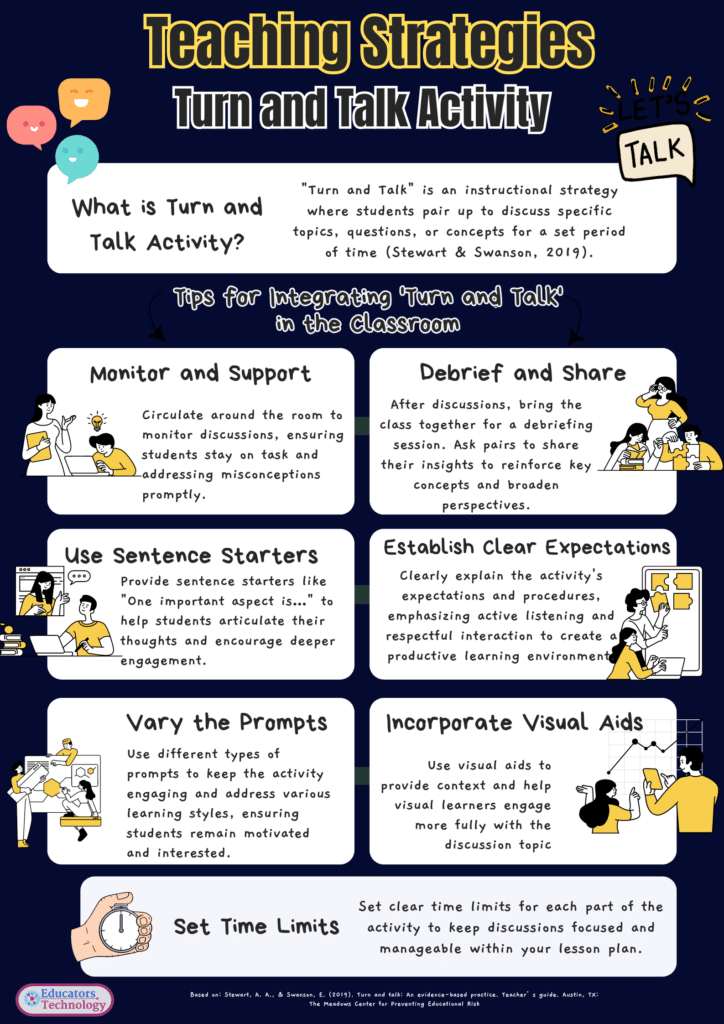

Today’s post is all about “Turn and Talk,” an engaging and interactive instructional strategy used in classrooms. If you haven’t heard about it or are looking for ways to implement it more effectively, this post is for you.
I will start with a definition of what “Turn and Talk” is all about, explaining its purpose and how it works in a classroom setting. Next, we will discuss practical tips for integrating “Turn and Talk” into your lessons, ensuring you can maximize its benefits. Then, I’ll provide some examples of “Turn and Talk” activities to inspire you and help you get started. Finally, we’ll conclude with insights from research, showcasing the proven benefits of this strategy for student learning and engagement.
What is Turn and Talk?
“Turn and Talk” is an instructional strategy where students pair up to discuss specific topics, questions, or concepts for a set period of time (Stewart & Swanson, 2019). This approach leverages structured peer interactions to enhance understanding, retention, and engagement with the material. Through verbal articulation and reciprocal roles, students reinforce learning concepts, improve vocabulary acquisition, and develop critical social and communication skills.
Practical Tips for Integrating ‘Turn and Talk’ in the Classroom
Here are some practical tips to help you effectively integrate “Turn and Talk” into your classroom activities. These insights, informed by Stewart and Swansson (2019), can enhance student engagement and learning outcomes through structured peer interactions.
- Monitor and Support: Circulate around the room to monitor discussions, ensuring students stay on task and addressing misconceptions promptly.
- Debrief and Share: After discussions, bring the class together for a debriefing session. Ask pairs to share their insights to reinforce key concepts and broaden perspectives.
- Use Sentence Starters: Provide sentence starters like “One important aspect is…” to help students articulate their thoughts and encourage deeper engagement.
- Establish Clear Expectations: Clearly explain the activity’s expectations and procedures, emphasizing active listening and respectful interaction to create a productive learning environment.
- Vary the Prompts: Use different types of prompts to keep the activity engaging and address various learning styles, ensuring students remain motivated and interested.
- Incorporate Visual Aids: Use visual aids to provide context and help visual learners engage more fully with the discussion topic.
- Set Time Limits: Set clear time limits for each part of the activity to keep discussions focused and manageable within your lesson plan.

Examples of “Turn and Talk” Activities
For inspiration, here are some examples of “Turn and Talk” activities you can use with your students to promote engagement and deepen understanding through peer discussions. These activities are designed to integrate seamlessly into various subjects and encourage collaborative learning.
- Literature Discussion:
After reading a chapter of a book, ask students to turn to a partner and discuss the main character’s motivations and actions. For example, “Why do you think the main character made that decision? How do you think it will affect the story?” Partner 1 shares their thoughts while Partner 2 listens, then they switch roles. - Math Problem Solving:
Present a challenging math problem on the board. Ask students to turn to their partner and discuss their strategies for solving it. For example, “What steps do you think we should take to solve this problem? Why do you think that approach will work?” Partner 1 explains their strategy while Partner 2 listens, then they swap roles. - Science Concepts:
After a lesson on ecosystems, have students pair up to explain how energy flows through a food web. For example, “Can you describe the path energy takes from the sun through the food web we studied?” Partner 1 discusses the concept while Partner 2 listens and asks clarifying questions, then they reverse roles. - Historical Events:
Have students discuss the causes and effects of a significant historical event, such as the signing of the Declaration of Independence. For example, “What were the main reasons the colonies wanted independence? What were the immediate effects after the declaration was signed?” Partner 1 outlines their ideas while Partner 2 listens and then they switch roles to provide their own insights. - Personal Connections:
Ask students to relate a lesson topic to their own experiences. For instance, after a lesson on teamwork, prompt students with, “Can you share a time when you worked as part of a team? What role did you play, and what was the outcome?” Partner 1 tells their story while Partner 2 listens and then they swap roles to share their own experience.
Importance of Turn and Talk’: Insights from Educational Research
The importance of “Turn and Talk” is well documented in the education literature. According to Jones et al. (2000), integrating mnemonic strategies with collaborative learning activities like “Turn and Talk” allows students to enhance their vocabulary acquisition significantly. By discussing and reinforcing learning concepts in pairs, students not only assimilate content more effectively but also retain it longer, illustrating the profound impact of collaborative learning on educational outcomes.
Further emphasizing the effectiveness of “Turn and Talk,” Vaughn and Martinez (2007) highlight how this strategy significantly improves educational outcomes for English Language Learners (ELLs) through structured, interactive, and discourse-based instruction. Their study shows that both ELLs and non-ELLs benefit from peer interactions within structured settings, which are core to the “Turn and Talk” activity. Through engaging in discussions and processing new information collaboratively, students can enhance their comprehension and mastery of content.
Locke and Fuchs’ study on peer-mediated instruction (PMI) further corroborates the benefits of structured peer interaction, akin to “Turn and Talk,” especially among students with behavioral disorders. Their research demonstrated significant improvements in both on-task behaviors and social interactions, underscoring the importance of reciprocal roles in the learning process. Through PMI, students engage in mutual teaching and learning roles, enhancing academic engagement and fostering a supportive classroom environment.
As the research demonstrates, “Turn and Talk” is a highly effective instructional strategy. Through “Turn and Talk,” students can engage in meaningful discussions, enhance their comprehension, and develop crucial social skills in a supportive classroom environment.
Related: What is The Think Pair Share Strategy?
Final thoughts
In this post, I talked about the “Turn and Talk” instructional strategy, highlighting its importance and effectiveness in the classroom. I covered the definition of “Turn and Talk,” provided practical tips for integrating it into your lessons, and shared several examples of activities to inspire you. Additionally, I discussed insights from research that underscore the benefits of this approach for student learning and engagement. I hope this information helps you effectively implement “Turn and Talk” in your teaching practice. The references below will also provide further reading and evidence to support the use of this valuable strategy.
References
- Jones, M. S., Levin, M. E., Levin, J. R., & Beitzel, B. D. (2000). Can Vocabulary-Learning Strategies and Pair-Learning Formats Be Profitably Combined? Journal of Educational Psychology, 92(2), 256–262. https://doi.org/10.1037/0022-0663.92.2.256
- Locke, W. R., & Fuchs, L. S. (1995). Effects of Peer-Mediated Reading Instruction on the On-Task Behavior and Social Interaction of Children with Behavior Disorders. Journal of Emotional and Behavioral Disorders, 3(2), 92–99. https://doi.org/10.1177/106342669500300204
- Stewart, A. A., & Swanson, E. (2019). Turn and talk: An evidence-based practice. Teacher’s guide. Austin, TX: The Meadows Center for Preventing Educational Risk. Retrieved from https://meadowscenter.org/wp-content/uploads/2022/04/TurnAndTalk_TeacherGuide1.pdf
- Vaughn, S., Martinez, L. R., Wanzek, J., Roberts, G., Swanson, E., & Fall, A.-M. (2017). Improving Content Knowledge and Comprehension for English Language Learners: Findings From a Randomized Control Trial. Journal of Educational Psychology, 109(1), 22–34. https://doi.org/10.1037/edu0000069
The post What Is Turn and Talk Strategy? appeared first on Educators Technology.